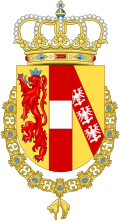Otto von Habsburg
Otto von Habsburg[1][2] (given names: Franz Joseph Otto Robert Maria Anton Karl Max Heinrich Sixtus Xaver Felix Renatus Ludwig Gaetan Pius Ignatius, Hungarian: [Ferenc József Ottó Robert Mária Anton Károly Max Heinrich Sixtus Xaver Felix Renatus Ludwig Gaetan Pius Ignác] Error: {{Lang}}: text has italic markup (help); 20 November 1912 – 4 July 2011),[3][4] was the last Crown Prince of the Austro-Hungarian Empire.[5] His father, Charles, was the Emperor of Austria and the King of Hungary. The murder of his great uncle, Archduke Franz Ferdinand of Austria was the event that led to the start of World War I.[5] His family fled Austria in 1919 after the war.[6]
During World War II he opposed the Nazis and Nazi Germany's takeover over Austria. Adolf Hitler ordered him to be put to death, but Habsburg left France and spent the war in the USA.[5] Habsburg gave up his claim to the throne in 1961, and was allowed to return to Austria five years later.[6] He was a member of the Christian Social Union of Bavaria and became a member of the European Parliament and pushed to get the former communist countries of Eastern Europe allowed into the European Union.[6]
He was buried in the Imperial Tomb in Vienna, but his heart was buried at an abbey near Budapest, Hungary, as part of a tradition that goes back to medieval times.[6]
During his lifetime he was also known as Archduke Otto of Austria.
Family
In 1951, Crown Prince Otto married Princess Regina of Saxe-Meiningen, they had seven children:
Otto Von Habsburg Media
The young crown prince Otto with his parents posing for official photographs on the occasion of the coronation in Budapest, 1916
Portrait by Oliver Mark, 2006
Otto (first right) with Helmut Kohl (third right) at the ceremony of the European Prize Coudenhove-Kalergi
Otto and Regina lying in repose in the Capuchin Church, Vienna, draped with the Habsburg flag. The insignias of the various orders and decorations accumulated by Habsburg are on display. The guards of honour are dressed in Austro-Hungarian uniforms.
References
- ↑ Dan van der Vat (4 July 2011). "Otto von Habsburg obituary". The Guardian (London). https://www.theguardian.com/world/2011/jul/04/otto-von-habsburg-obituary. Retrieved 6 July 2011.
- ↑ Otto was born as His Imperial and Royal Highness Archduke Otto of Austria, Royal Prince of Hungary and Bohemia and became the Crown Prince of these countries in 1916. After 1919, titles of nobility were formally abolished in Austria, thus in official use the "von" disappeared before Habsburg. The same applied after Habsburg became a German citizen (see Printausgabe der deutschen Wochenzeitung die Zeit of 21 July 2011, p. 36). By courtesy, he would also be referred to by the European royal and princely courts by his former style and title, i.e. as His Imperial and Royal Highness Archduke Otto of Austria. In the Austrian republic the authorities referred to him from 1919 as Otto Habsburg-Lothringen, a name he never used himself. Otto did not live in Austria after 1919, and his citizenship there was revoked by Adolf Hitler in 1941, making him stateless. His Austrian citizenship was only restored in 1965. Otto later became a citizen of Germany (in 1978) and Croatia (in 1990) and was issued passports of these countries, where his official name was Otto von Habsburg. As a Member of the European Parliament for Germany, his official name in the European Union was Otto von Habsburg. On his website, he used the style and name His Imperial and Royal Highness Dr. Otto von Habsburg.
- ↑ Nicholas Kulish (4 July 2011). "Otto von Hapsburg, a Would-Be Monarch, Dies at 98". The New York Times. https://www.nytimes.com/2011/07/05/world/europe/05habsburg.html?_r=1&ref=deathsobituaries.
- ↑ "Habsburg: Last heir to Austro-Hungarian empire dies". BBC News. 4 July 2011. https://www.bbc.co.uk/news/world-europe-14019319. Retrieved 5 July 2011.
- ↑ 5.0 5.1 5.2 van der Vat, Dan (4 July 2011). "Otto von Habsburg obituary | World news | The Guardian". The Guardian (London: GMG). . . http://www.guardian.co.uk/world/2011/jul/04/otto-von-habsburg-obituary. Retrieved 17 July 2011.
- ↑ 6.0 6.1 6.2 6.3 "Habsburg: Funeral held for last Austro-Hungarian heir". BBC News. BBC. 16 July 2011. Retrieved 17 July 2011.








